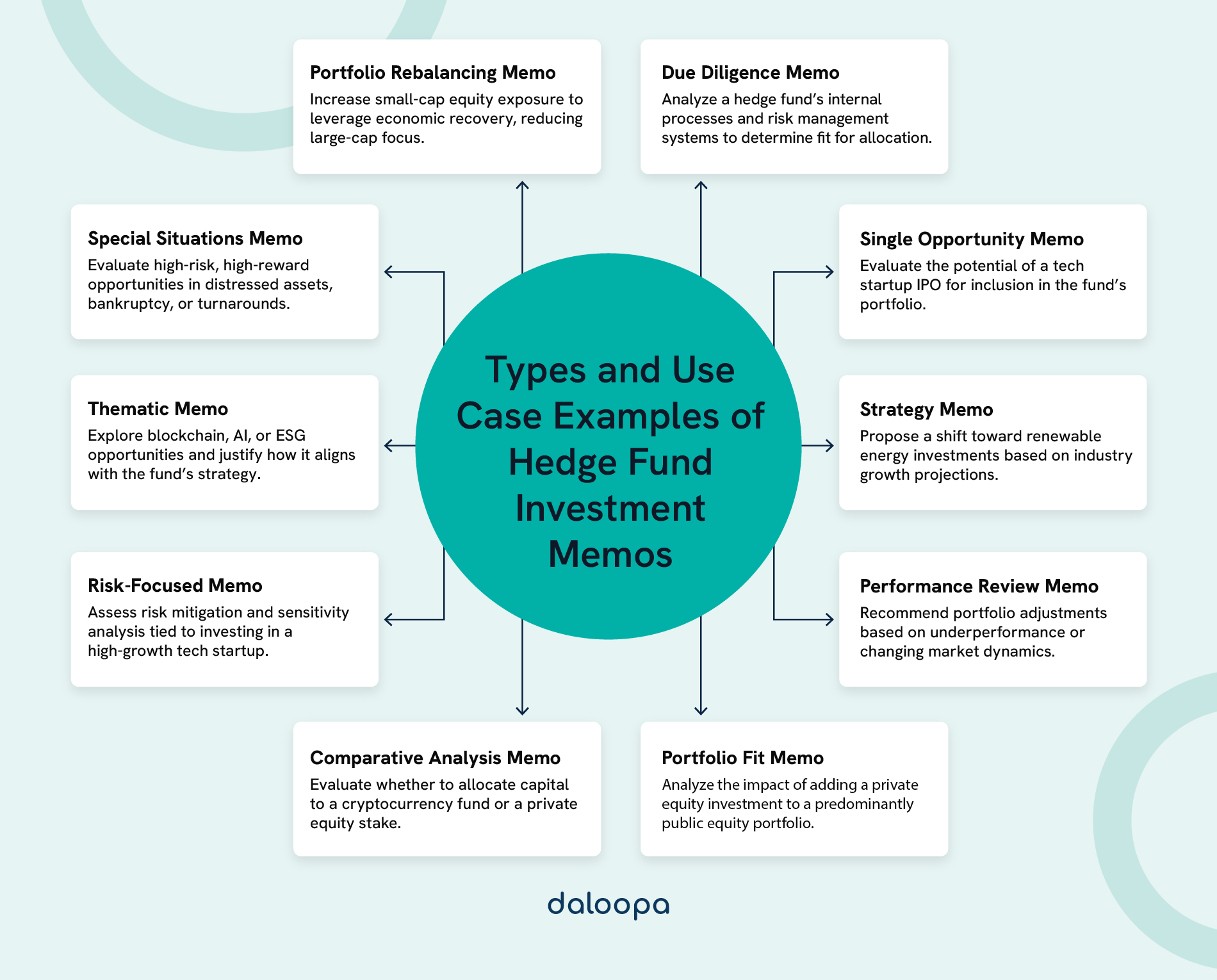Hedge fund investment memos play a pivotal role in showcasing a fund’s strategy, performance, and risk management approach to potential investors. A well-prepared investment memo effectively communicates the fund’s distinctive strengths, guiding principles, and market positioning, offering a comprehensive view that inspires confidence and commitment.
Such a memo, like the hedge fund investment memo example that will be detailed here, requires a deep dive into the fund’s competitive advantages and a forward-looking perspective. It must convincingly demonstrate why the fund is a smart choice for investment, supported by robust data and a proven track record.
In this guide, we will outline essential tips and strategies for writing a hedge fund investment memo that stands out to investors.
Key Takeaways
- Investment memos outline hedge fund strategies to attract investor interest and inform decision-making.
- Strong memos highlight unique advantages and address potential concerns effectively, offering clarity and reassurance.
- Combining clarity, data, and strategic foresight is key to creating impactful and compelling communication.
What Is a Hedge Fund Investment Memo?
A hedge fund investment memo is a detailed document that introduces potential investors to a fund. These memos serve as a comprehensive guide, explaining the fund’s approach, track record, and risk management strategies.
Unlike standard marketing materials, investment memos prioritize depth, data-driven insights, and transparency, enabling investors to make well-informed decisions about their capital allocation and understand how the fund operates within its market context.
Key Components
- Fund Objectives and Strategy: Methods used to achieve target goals.
- Historical Performance Metrics: Detailed data showcasing returns and volatility.
- Team Expertise: Profiles of fund managers and decision-makers.
- Risk Management Frameworks: Approaches for identifying and mitigating risks.
- Financial Projections and Fee Structures: Expected returns, costs, and investment thresholds.
Investment memos often incorporate visuals—such as graphs, tables, and charts—to enhance understanding, transforming complex data into actionable insights.
An investment memo is a persuasive pitch and due diligence document for fund managers. It differentiates the fund from competitors while addressing the rigorous expectations of investors. For investors, these memos establish a foundation for analyzing a fund’s strategy and risk profile, ensuring alignment with their goals.

Purpose and Importance of an Investment Memo
Investment memos are more than just strategy presentations; they are critical decision-making tools. They help frame investment opportunities, guide discussions with investment committees, and establish a foundation for informed due diligence. They provide a structured narrative that ensures all aspects of an investment are evaluated systematically and thoroughly, reducing the risk of oversight in critical areas.
Key Objectives:
- Articulating the Investment Thesis: Explaining how the fund exploits market opportunities to generate returns.
- Balancing Risks and Rewards: Acknowledging potential risks while demonstrating mitigation strategies.
- Ensuring Strategic Alignment: Presenting the investment’s alignment with long-term fund objectives.
- Creating Historical Records: Documenting strategies for future refinement and comparison.
Standardizing memos improves the overall consistency of evaluations, enabling better comparisons across diverse opportunities. For investors, consistency inspires confidence in the fund’s diligence and operational professionalism.
Investment memos also enhance communication between fund managers and their investors. By documenting analysis and insights, they showcase transparency and professionalism, vital elements for fostering trust in the fund’s long-term capabilities and maintaining investor interest even during periods of market volatility.
Key Components of a Hedge Fund Investment Memo
An investment memo needs to be meticulously structured, ensuring that all relevant aspects of the fund are addressed in detail. Each section should build on the previous one, creating a cohesive narrative that thoroughly addresses the needs of potential investors. A hedge fund investment memo example can serve as a useful reference to understand how to effectively structure and present these critical components.
Executive Summary
The executive summary is the reader’s introduction to the investment memo and should immediately engage their attention. This section condenses the memo’s most critical information into a concise format that provides a snapshot of the fund’s strategy, performance, and potential.
Essential Elements
- Fund Goals and Strategy: Brief but impactful description of the fund’s mission.
- Performance Metrics: Highlight key figures, such as risk-adjusted returns or Sharpe ratios.
- Market Edge: What differentiates the fund—proprietary strategies, sector expertise, or unique access.
The executive summary should give readers a clear understanding of why the fund is an attractive investment opportunity and motivate them to delve deeper into the document, setting the stage for a persuasive narrative.
Investment Thesis
The investment thesis provides the intellectual foundation of the memo. It explains the fund’s approach to generating returns and positions its strategy in the broader market context. This section should articulate the “why” behind the fund’s methodology while demonstrating thoughtfulness and strategic clarity.
Key Questions
- What specific inefficiencies does the fund target?
- How does the strategy create a competitive edge?
- What are the expected returns, and how are risks balanced?
Specific examples, such as case studies of successful investments or actionable market insights, help solidify the fund’s value proposition. This section builds investor confidence by demonstrating how the fund creates value and navigates complex market landscapes.
Market Analysis
Investors need confidence that the fund’s strategy aligns with current and future market conditions. The market analysis section delves into the broader economic and industry trends that underpin the fund’s approach.
Key Areas
- Market Size and Growth: Include projections and growth rates (e.g., CAGR) from credible sources like Bloomberg or Preqin.
Example: “The global hedge fund industry is expected to grow at a CAGR of 8% through 2026, with emerging markets attracting $250 billion in new capital annually.” - Competitive Analysis: Highlight what sets the fund apart.
- Regulatory Environment: Discuss potential challenges and the fund’s proactive measures.
Incorporating data visualizations like trend lines or pie charts can clarify complex trends and underscore the fund’s grasp of market dynamics. Thoughtful market analysis ensures investors that the fund operates with a thorough understanding of its environment.
Company Overview
This section provides an in-depth look at the fund itself. It offers insight into the fund’s organizational structure, guiding philosophy, and key contributors.
Key Points
- Team Experience: Highlight notable achievements.
Example: “John Doe, CFA, led the Fixed Income Desk at Firm Y, managing $5B in AUM with an average annual return of 20%.” - Fund Milestones: Significant performance benchmarks.
- Current AUM and Investor Base: Adds credibility and transparency.
This section should underscore the fund’s credibility and highlight how its internal capabilities align with its investment strategy. Investors are often just as interested in the people behind the fund as in its performance, making this section critical.
Financial Projections
Financial projections are a cornerstone of any investment memo. This section provides quantitative insights into the fund’s performance expectations.
Key Details
- Expected Annualized Returns: Provide precise figures under different market scenarios.
Example: “We anticipate annualized net returns of 12-15%, aligning with top-quartile funds in similar strategies (Morningstar, 2023).” - Fee Structure: State management and performance fees.
- Growth Trajectory: Use visuals to highlight the fund’s path to scaling AUM.
When writing a hedge fund investment memo, presenting historical data alongside forward-looking projections establishes a sense of continuity and realism, reinforcing investor confidence. Visual aids like tables and graphs further enhance understanding and engagement.
Risk Assessment and Mitigation
Investors need assurance that the fund has thoroughly considered potential challenges and devised strategies to mitigate them.
Points to Cover
- Specific market risks and their potential impact.
- Internal risks, such as operational inefficiencies or personnel turnover.
- Compliance and regulatory risks focus on how these are managed proactively.
A table summarizing risks alongside corresponding mitigation strategies can be especially effective. This section provides a balanced perspective, ensuring investors that the fund is prepared for uncertainties.
Crafting a Compelling Investment Memo
The power of a well-written investment memo lies in its ability to inform, reassure, and inspire. Achieving this requires careful attention to hedge fund investment memo structure, investor concerns, and the overarching narrative.
For those writing a hedge fund investment memo, focusing on clarity, compelling insights, and data-driven arguments is essential for success. Combining precision, transparency, and strategic foresight, a hedge fund investment memo becomes a powerful tool for attracting capital and building trust with sophisticated investors.
Structuring the Memo for Impact
An effective memo follows a logical progression, which is essential when considering the hedge fund investment memo structure:
- Start with a concise executive summary.
- Detail the fund’s strategy and competitive edge.
- Provide a market analysis to contextualize the fund’s approach.
- Highlight past performance and team expertise.
- Address risk management strategies.
- Conclude with investment terms and additional key information.
Addressing Investor Concerns
Acknowledging potential concerns demonstrates foresight. A well-crafted memo might include:
- Strategies to navigate market risks
- Transparent reporting practices
- Honest reflections on past challenges and lessons learned
When writing a hedge fund investment memo, providing concrete examples of risk management enhances credibility.
Inspiring Enthusiasm and Confidence
Highlighting the fund’s successes, unique insights, and forward-looking vision can create excitement. Case studies, visualized projections, and investor testimonials add authenticity and social proof.
Essentials to Crafting a Strong Investment Memo
Success lies in meticulous planning and execution. A strong memo:
- Begins with a compelling executive summary.
- Offers clear market insights.
- Presents realistic financial projections.
- Highlights the team’s expertise.
- Transparently addresses risks and challenges.
- Uses visuals to support its narrative.
- Ends with a clear call to action.
By following the hedge fund investment memo structure, and combining precision, transparency, and strategic foresight, a hedge fund investment memo becomes a powerful tool for attracting capital and building trust.
Hedge Fund Investment Memo Example
To further explain the steps for a hedge fund investment memo, take a look at this hypothetical scenario based on a made-up business called AlphaEdge Capital Fund. This hedge fund investment memo example will illustrate how to structure key sections and present critical data to attract potential investors effectively.
Executive Summary
AlphaEdge Capital Fund focuses on mid-cap technology equities, particularly in AI and automation sectors, targeting 20% annualized returns with controlled volatility. Since inception, the fund has achieved a 23.5% net annualized return, outperforming the NASDAQ Composite by over 10% annually.
Investment Thesis
The fund exploits pricing inefficiencies in under-researched mid-cap tech stocks. For example, its investment in ClearTech Systems 2023 generated a 130% return within 12 months. AlphaEdge combines proprietary algorithms and deep fundamental analysis to identify undervalued opportunities while managing downside risk through selective short positions and hedging strategies.
Market Opportunity
AI and automation markets are projected to grow at a CAGR of 18% over the next five years (Bloomberg, 2023). Mid-cap stocks in these sectors offer high growth potential, often overlooked by large institutional investors.
Risk Management
The fund employs advanced hedging techniques and sector diversification to mitigate market volatility. In Q2 2022, strategic hedges offset losses in declining semiconductor stocks, safeguarding overall portfolio performance.
Call to Action
AlphaEdge is accepting new capital until October 31, 2024, as part of its quarterly raise. Investors are encouraged to contact the team to explore this opportunity and align capital with a top-performing strategy.
A well-crafted hedge fund investment memo can make all the difference in securing investor interest and funding. By reviewing this hedge fund investment memo example, you can better understand how to present your fund’s unique strengths and strategies with clarity and precision.
Elevate Your Hedge Fund’s Investment Memos
Take advantage of Daloopa’s AI-powered financial modeling tools. Our platform streamlines the integration of comprehensive, accurate, and up-to-date financial data into your models, enhancing clarity and impact. By automating data updates, Daloopa lets you focus on strategic analysis and decision-making, ensuring your investment memos stand out to sophisticated investors.
Experience the efficiency and precision that top-performing investment firms trust. Request a demo today to see how Daloopa can transform your financial modeling process.



